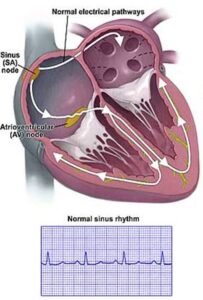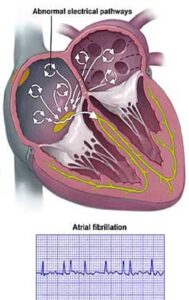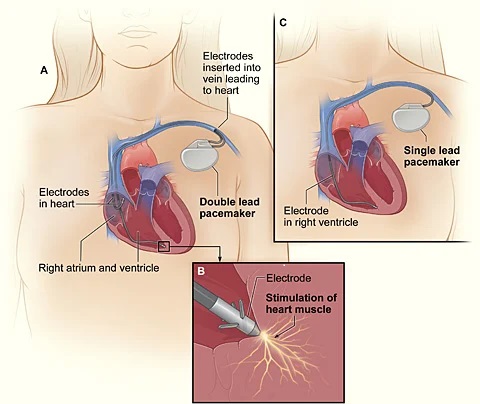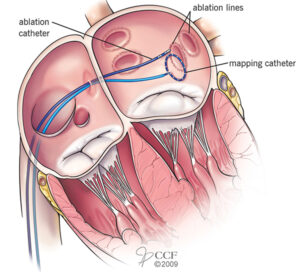Heart Rhythm Management
Arrhythmia
An arrhythmia is an irregular heartbeat. A person’s heart may beat too quickly, too slowly, too early or with an irregular rhythm. This occurs when the electrical signals that coordinate heartbeats, are not working correctly. An irregular heartbeat may feel like a racing heart or fluttering.
Many arrhythmias are harmless. However, if they are highly irregular or result from a weak or damaged heart, arrhythmias can cause severe symptoms and complications.

https://www.heartfoundation.org.nz/your-heart/heart-conditions/arrhythmia
https://www.thehearttrust.org.nz/stories/id/91
Atrial Fibrillation (AF) – also called A Fib
The most common kind of abnormal heart rhythm condition is atrial fibrillation (AF), which causes an irregular and often fast, heart rhythm. The upper chambers of the heart, or atria, may beat as often as 400 times a minute, about 4 times faster than normal. Although it is not life threatening AFib can lead to palpitations,fatigue and heart failure.

For more information go to: https://www.heartfoundation.org.nz/your-heart/heart-conditions/atrial-fibrillation
Other Arrhythmias include:
- Supraventricular Tachycardia (SVT): – this group of arrhythmias starts in the upper chambers of the heart called the Atria. With SVT your heart rate increases very suddenly to over 100 beats per minute. This can happen when you’re at rest or when you are exercising. Anyone can develop a rapid heart-beat, even a young person without other heart problems. However, problems are more common in those:
- with previous heart trouble
- Over 65 years of age
- who have suffered damage caused by a heart attack, cardiac surgery, or other conditions.
- with rare, inherited heart electrical defects.
- Atrial Flutter: – this is a fast heart rate that starts in the top chambers of the heart (atria). With atrial flutter your atria often beat at a rate as fast as 300 beats per minute. The rhythm can be regular or irregular. It often occurs in people who also have atrial fibrillation.
- Wolff-Parkinson-White Syndrome (WPW): – is a condition which causes fast, irregular heartbeats. For some this can lead to fainting.
- Long QT syndrome, Brugada Syndrome:- these are rare, inherited heart conditions. See Long QT for more information.
- Ventricular Tachycardia:- a fast heartbeat originating in the lower chambers of the heart (ventricles). It can be a life threatening arrhythmia.
- Heart Block:- happens when the electrical messages that tell your heart to beat are delayed or blocked. This causes your heart to beat at a slow rate of less than 60bpm.
- Tachybrady Syndrome (Sick Sinus Syndrome):- is a problem with your heart’s sinus node, (sometimes called your heart’s natural pacemaker). It includes periods of very fast or very slow heart beats.
- Ectopic Heartbeats:- are when your heart misses a beat or adds an extra beat. Usually they are not serious, however if they are happening regularly, or you feel unwell, then see your doctor.
Arrhythmia Treatments
These depend on the type and severity of the arrhythmia. In some cases no treatment is necessary. Treatment options include medications, lifestyle changes, invasive therapies, electrical devices or surgery.
A variety of drugs are available to treat arrhythmias. Because everyone is different, it may take trials of several medications and doses to find the one that works best for you. Several types of drugs are used:
- Anti-arrhythmic drugs – drugs used to convert the arrhythmia to sinus rhythm (normal rhythm) or to prevent an arrhythmia.
- Heart-rate control drugs – drugs used to control the heartrate
- Anticoagulant drugs (“blood thinners”) – drugs such as Warfarin, Dabigatran, Rivaroxaban and Apixaban. These reduce the risk of strokes.
Therapeutic Procedures
Cardioversion
Cardioversion is a procedure which converts an abnormally fast heart rate or cardiac arrhythmia, to a normal rhythm by using electricity or drugs. We usually use synchronised electrical cardioversion to deliver a small electric shock to jolt the heart back into a normal rhythm. This is often used to treat AFib. If the arrhythmia has been present for more than 48 hours, the patient will usually be treated with anticoagulant medication, such as Warfarin, for at least 3 weeks prior to the cardioversion. This ensures that there is no blood clot in the heart which could be released into the blood stream by the cardioversion causing problems such as a stroke. A transoesophageal echo, TOE, may be performed immediately prior to the cardioversion to exclude the presence of a blood clot within the heart.
The procedure is under a short general anaesthetic, so it is important not to have anything to eat or drink for 4 to 6 hours before the procedure. The shock is delivered through electrode pads placed on the chest and the back. As many a 3 shocks may be given in an attempt to restore the heart to a normal rhythm. Usual medications are stopped on the morning of the procedure, unless directed by the cardiologist.
After the cardioversion the patient is monitored for 1 hour, and should not drive for 24 hours. A report will be sent to the referring doctor or GP. The doctor performing the procedure will explain ongoing treatment and medication . If the patient has been on Warfarin, it is important to continue this, usually for at least 3 weeks after the cardioversion.
https://www.heartfoundation.org.nz/your-heart/heart-treatments/medications/anticoagulants/
Electrophysiology Study (EPS)
This is a diagnostic test to assess your hearts electrical conduction system or activity. These studies are performed to understand and diagnose an abnormal heart rhythm. This is done by placing catheters up through the groin into the heart, and checking and testing the electrical activity. Once the source of the arrhythmia is confirmed, the Doctor will decide whether catheter ablation can treat the problem and if it is safe to do so.
Catheter Ablationatheter Ablation
During an ablation, energy is delivered through a catheter to a small area of tissue inside the heart causing the arrhythmia. This energy “disconnects” the pathway of the abnormal rhythm.
- There are 2 types of energy used in ablation. Radiofrequency (RF) or heat which cauterises or burns the tissue, and Cryo energy which uses intense cold, freezing the tissue. Cryo is most often used for the treatment of atrial fibrillation.
Catheter ablation is used to treat rapid heartbeats that begin in the upper chambers, or atria, of the heart. As a group, these are know as supraventricular tachycardias, or SVTs. Types of SVTs are:
- Atrial Fibrillation
- Atrial Flutter
- AV Nodal Reentrant Tachycardia
- AV Reentrant Tachycardia or Wolf Parkinson White (WPW) Syndrome
- Atrial Tachycardia
Catheter ablation can also treat heart rhythm disorders that begin in the heart’s lower chambers, (ventricles), such as ventricular tachycardia (VT), which can be a life-threatening arrhythmia.
Refer to the following link for more information: Ablation of Supraventricular Tachycardia
Pulmonary Vein Isolation, PVI, for Atrial Fibrillation.
For patients with atrial fibrillation, isolation of the pulmonary veins is a type of ablation procedure that targets areas thought to trigger atrial fibrillation. Studies have shown that the extra electrical signals that cause AFib, are thought to originate around the pulmonary veins. PVI ablation is used to isolate these areas. Bursts of energy are applied in a circle around the area where the pulmonary veins attach to the left atria. This energy damages the tissue and causes scar tissue to form. This scar tissue blocks the extra electrical signals from the pulmonary veins so that they can no longer trigger the abnormal rapid rhythm. This process is carried out around the opening of all four pulmonary veins resulting in a return to normal sinus rhythm.
Refer to the following link for more information:
Device Insertion
Pacemaker Insertion
Normally the heart is signaled to contract by an electrical impulse that starts in the sinus node at the top the of right atrium (top chamber of the heart). This impulse travels through the hearts electrical system, “wires” to the muscles of the lower chambers of the heart (the ventricles), telling them to contract and cause a heartbeat. This natural system helps the heart pump in a regular (sinus), rhythm. A problem with any part of this system can cause a slow heart rate. In this case an artificial pacemaker may be needed to take over the job of the hearts own electrical system and prevent the slow heart rate.
A permanent pacemaker is a device that is implanted into the body just below the collarbone. They only weigh about 30grams and measure 3-4 cm across. They contain a computer with memory and electrical circuits, a powerful battery (generator) and special wires called leads. The generator creates electrical impulses that are carried by the leads to the heart muscle, signaling it to pump.
The insertion procedure usually takes around an hour and does not require a general anaesthetic or open-heart surgery, only local anaesthetic. The generator is implanted into a pocket made under the skin. The leads are placed into a vein near the collarbone, and fed down into the heart using X-ray guidance. One end of the leads touch the heart muscle and the other end is connected to the pacemaker generator. The pacemaker is then programmed to send signals to the heart to ensure the correct heart rhythm. The pacemaker is monitored regularly to make sure it is working properly and the settings can be changed at any time if necessary. The battery life of the generator lasts 5-10 years and must be replaced when it is due to run out. This procedure is very similar to the pacemaker insertion procedure. The outer casing of pacemakers is designed so that it will rarely be rejected by the body’s immune system. It is usually made of titanium, which is inert within the body.
Placement of a pacemaker must be checked by X-ray and a pacing check must be done prior to discharge.

When are Pacemakers Used
Pacemakers may be prescribed for a number conditions, including:
- Bradycardia – a condition in which the heart beats too slowly, causing symptoms such as fatigue, dizziness, or fainting spells.
- Atrial Fibrillation – a common heart rhythm disorder in which the heart beats too fast and chaotically. People with atrial fibrillation can also sometimes have slow rhythms. Medications used to control atrial fibrillation may result in slow rhythms, which can be treated by pacemakers.
- Heart Failure – a condition in which the heartbeat is not strong enough to carry a normal amount of blood and oxygen to the brain and other parts of the body. A special pacemaker can be programmed to increase the force of heart muscle contractions. This is called “Biventricular Pacing” or “Resynchronization” therapy.
Types of Pacemaker
- Single Chamber Pacemaker: These have one wire which is placed in the right upper chamber (atrium), or the lower chamber (ventricle).
- Dual Chamber Pacemaker: These have 2 wires, one in the atrium and one in the ventricle.
- Rate Responsive Pacemakers: These adjust the heart rate to a patient’s level of activity. They ape faster when a patient is exercising and slower when a patient is resting.
- Implantable Cardioverter-Defibrillator: This is a small battery powered device placed in a pocker under the skin just under the collarbone. It constantly monitors heart rhythm and detects irregular heartbeats. When it detects an abnormal rhythm, it delivers energy, a shock, via one or more leads connected to the heart muscle to fix the abnormal rhythm. You might need a ICD if you have a dangerously fast heartbeat (ventricular tachycardia), or a chaotic heartbeat that keeps your heart from supplying enough blood to the rest of your body (ventricular fibrillation).
- Biventricular Pacemakers, also called Cardiac Resynchronization Therapy or CRT:
- Cardiac resynchronization therapy (CRT) is a treatment for heart failure in people whose ventricles don’t contract in a coordinated fashion, heart failure.
- If you have heart failure, your heart muscle is weakened and may not be able to pump out enough blood to support your body. This can be worsened if your heart’s chambers aren’t in sync with each other. Cardiac resynchronization therapy may reduce your symptoms of heart failure and lower your risk of heart failure complications, including death.
- The CRT pacing device (also called a biventricular pacemaker) is an electronic, battery-powered device that is surgically implanted under the skin.
- The device has 2 or 3 leads (wires) that are positioned in the heart to help the heart beat in a more balanced way. The 3 wires are positioned, one in the right atrium, one in the right ventricle and a third in the left ventricle.
- When your heart rate drops below the set rate (programmed by your doctor), the device generates (fires) small electrical impulses that pass through the leads to the heart muscle. These impulses make the lower chambers (ventricles) of the heart muscle contract, causing the right and left ventricles to pump together. The end result is improved cardiac function.
- Sometimes the device also contains an implantable cardioverter-defibrillator (ICD), which can deliver an electrical shock to reset your heartbeat if your heart rhythm becomes dangerously erratic.
Monitoring Device Implant – Loop Recorder
An implantable loop recorder is a type of heart-monitoring device that records your heart rhythm continuously for up to three years. It records the electrical signals of your heart and allows remote monitoring. They are very small devices that are inserted just under the skin of your chest wall, under local anaesthetic.
This is a useful diagnostic tool when patients experience symptoms such as syncope , seizures, recurrent palpitations, light-headedness’, or dizziness regularly but not often enough to be captured by a 24-hour or 30-day external monitor. Implantable loop recorders have a long battery life (2 to 3 years) and so the heart can be monitored for an extended period. For example, if you have a standard ECG to help figure out why you’re having fainting spells, it will only record any related heart rhythm abnormalities during the few minutes of the monitoring period — usually about five minutes. Because an implantable loop recorder monitors your heart signals for a much longer time, it’s more likely to capture what your heart is doing during your next fainting spell. This information may help your doctor make a definite diagnosis and develop a treatment plan.
Refer to the following link for more information: Loop Recorder Brochure

